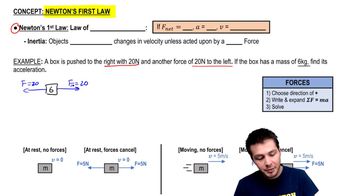Here are the essential concepts you must grasp in order to answer the question correctly.
Newton's First Law of Motion
Newton's First Law states that an object at rest will remain at rest, and an object in motion will continue in motion at a constant velocity unless acted upon by a net external force. In this scenario, since the box is moving at a steady speed on frictionless ice, it indicates that the net force acting on the box is zero, meaning the tension in the rope must balance any other forces acting on the box.
Recommended video:
Tension in a Rope
Tension is the force transmitted through a rope or string when it is pulled tight by forces acting from opposite ends. In this case, the tension in the rope is responsible for maintaining the box's steady motion. Since the box is moving at a constant speed, the tension must equal any opposing forces, which in this case is zero due to the absence of friction.
Recommended video:
Calculating Tension in a Pendulum with Energy Conservation
Kinematics of Constant Velocity
Kinematics describes the motion of objects without considering the forces that cause the motion. When an object moves at a constant velocity, its acceleration is zero. This means that the forces acting on the object are balanced. In the context of the box moving at 5.0 m/s, the steady speed indicates that the tension in the rope does not need to overcome any frictional forces, leading to a straightforward calculation of tension.
Recommended video:
Phase Constant of a Wave Function



